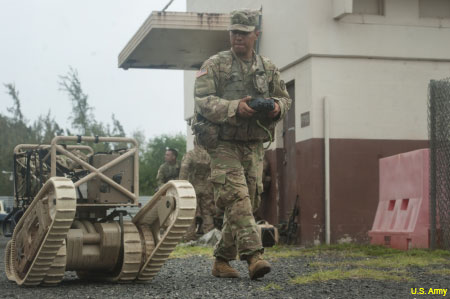
Army puts battlefield robots to the test
At an exercise in Hawaii, troops test a pocket-sized ISR drone and a robotic ground vehicle that can quietly carry up to 600 pounds of supplies.
The Army, which like other military services has been working to increase the effectiveness of deployed troops on expeditionary missions, recently demonstrated a couple new technologies that will play a big part in the future of battlefield operations: robotics.
At an exercise called PACMAN-I, held at Marine Corps Training Area Bellows, Hawaii, soldiers tested a palm-sized personal unmanned aerial system called the PD-100 and an unmanned ground vehicle called MUTT, for Multipurpose Unmanned Tactical Transport.
The purpose is not just to enhance battlefield performance but also to assist rescue efforts.
"When we go to a place where there may be the need for us to do reconnaissance type work in a disaster area…they'll be able to use these systems that way," Tollie Strode Jr., senior project officer at Maneuver Center of Excellence Maneuver Battle Lab at Fort Benning, Ga. said in an Army release. "That isn't trying to find someone to shoot, that's trying to find someone to save."
One device tested was the PD-100 pocket-sized UAS, which researchers at the Natick Soldier Research, Development and Engineering Center in Massachusetts have been working on for several years. Researchers started with a commercial system, the Prox Dynamics' PD-100 Black Hornet, and adapted it for military use under its Cargo Pocket Intelligence, Surveillance and Reconnaissance, or CP-ISR, program.
The device is intended to give soldiers the kind of ISR they’re used from larger systems, but in constrained environments where those larger UAS might not work, such as in areas with thick tree cover, inside buildings or in densely packed villages.

A soldier operates the MUTT ground vehicle.
The other robotic device tested during the two-week exercise was the MUTT, made by General Dynamics, a four-wheeled vehicle that can navigate steep slopes, sand, mud and water while carrying about 600 pounds of supplies. What’s more it’s quiet, which is an advantage in the field (noise is one reason the Army and Marines gave up, at least temporarily, on their robotic, though loud, “pack mule.”)
Soldiers who used the MUTT said it was easy to operate, the Army said, although offered feedback on potential improvements,
"There are two different controls, one is used just by one hand and the other actually has a screen on it that controls the turret itself and the MUTT," said Spc. Cole Cumby. "I like working with it, there's a lot of good things about it, and there are things I'd change..."
The Army is hoping that te4sts such as PACMAN-I will not only help improve the products but also get them into the field more quickly. "We need to be making sure we're fielding new technology as quickly as we can," said Army Secretary Eric Fanning, who attended the exercises. "It doesn't do any good if we're just investing in great technology if we don't actually get it into the field for soldiers."